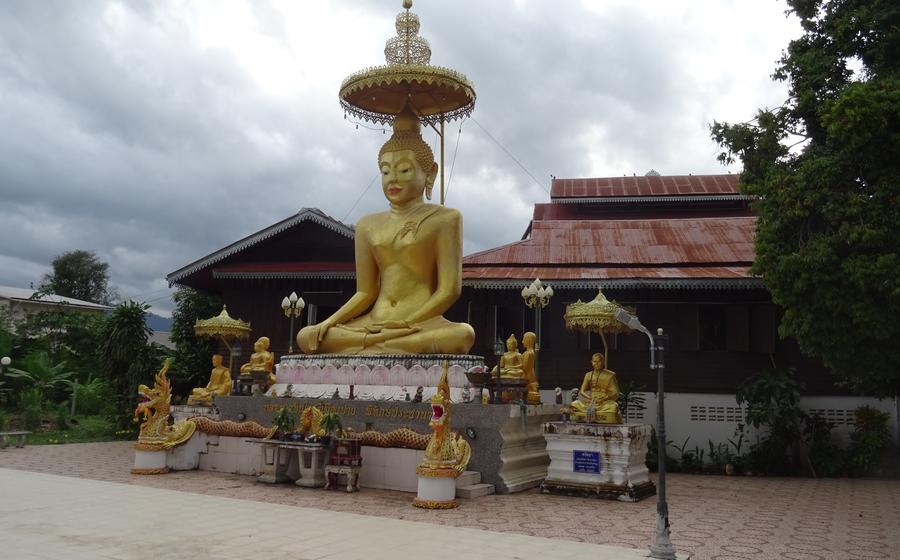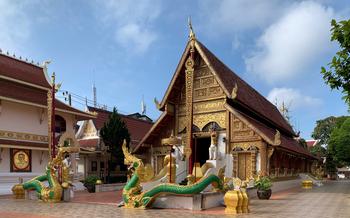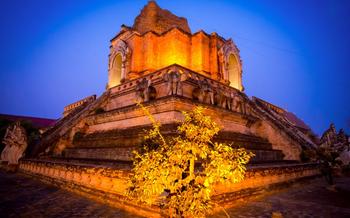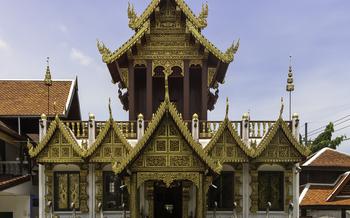
Wat Luang
- Wat Luang: A Sacred Abode of Serenity
- Tracing the Footsteps of History
- Marveling at Architectural Masterpieces
- Finding Inner Peace in a Sacred Space
- Exploring the Temple Grounds
- Paying Homage to the Buddha
- Immerse Yourself in Local Traditions
- Exploring the Surrounding Area
- Capturing the Beauty of Wat Luang
- Finding Your Zen at the Temple
- Unveiling the Temple's Secrets
- Dress Code and Etiquette
- Photography and Social Media
- Exploring Beyond Wat Luang
- Insider Tip: Uncovering a Hidden Gem
Wat Luang: A Sacred Abode of Serenity
Tucked away in the enchanting town of Pai, nestled amidst rolling hills and verdant rice paddies, lies Wat Luang, a sacred abode of serenity that beckons travelers and pilgrims alike. Steeped in history and cultural significance, this ancient temple exudes an aura of peace and tranquility, inviting visitors to immerse themselves in its spiritual atmosphere and marvel at its architectural splendor.
Wat Luang's origins can be traced back to the 14th century, making it one of the oldest and most revered temples in the region. Built by skilled Lanna craftsmen, the temple showcases a harmonious blend of traditional Lanna and Burmese architectural styles, creating a unique and captivating visual experience.
Throughout the centuries, Wat Luang has been a focal point of religious devotion for the local community. Locals flock to the temple to pay homage to Buddha, seek blessings, and participate in various ceremonies and festivals. The temple's serene ambiance and sacred atmosphere make it an ideal place for meditation and spiritual contemplation.
When visiting Wat Luang, it is essential to dress respectfully and observe proper etiquette. Remove your shoes before entering the temple grounds, maintain silence, and refrain from pointing your feet towards Buddha images. Visitors are welcome to make offerings of flowers, candles, or incense to show their devotion and respect.
Tracing the Footsteps of History
Wat Luang's origins are shrouded in mystery, with local legends attributing its founding to a wandering monk who was guided by a divine vision. Over time, the temple has undergone several renovations and expansions, reflecting the changing political and cultural landscape of the region.
During the Lanna Kingdom, Wat Luang flourished as a center of religious and cultural learning. It attracted renowned monks and scholars who contributed to its growing reputation as a sacred site. Influences from neighboring civilizations, such as Burma and China, can be seen in the temple's architecture and artistic motifs.
Ancient inscriptions and murals within the temple grounds tell the stories of past rulers, battles, and religious events. These intricate artworks provide a glimpse into the rich history of Pai and the surrounding region. The temple has played a significant role in shaping the local community, serving as a place of worship, education, and social gatherings for generations.
Marveling at Architectural Masterpieces
Wat Luang stands as a testament to the exquisite craftsmanship and rich artistic heritage of the Lanna Kingdom. Its architecture seamlessly blends traditional Lanna and Burmese styles, creating a unique and captivating visual experience. Intricate carvings adorn every corner of the temple, from the towering stupas to the delicate eaves. The main shrine, with its graceful curves and intricate details, is a true masterpiece.
Symbolic elements abound throughout the temple's architecture. The stupas, for example, represent the Buddha's journey to enlightenment, while the elaborate carvings depict scenes from Buddhist mythology. The temple's design also incorporates elements from nature, with mythical creatures and floral motifs adding a touch of whimsy and wonder.
Preservation efforts have played a crucial role in maintaining the temple's architectural integrity. Over the years, restoration projects have been undertaken to ensure that Wat Luang's beauty and grandeur continue to captivate visitors for generations to come.
Finding Inner Peace in a Sacred Space
Wat Luang emanates a profound sense of serenity, serving as a sanctuary for spiritual seekers and those yearning for inner peace. The tranquil ambiance and serene surroundings create an ideal environment for meditation and self-reflection. Visitors are welcome to sit in quiet contemplation, immersing themselves in the temple's sacred atmosphere. Guided meditation sessions or retreats may also be available, offering a deeper exploration of mindfulness practices. Whether seeking solace or seeking to cultivate inner peace, Wat Luang provides a sacred space to connect with oneself and the divine.
Etiquette and Customs for Visitors
When visiting Wat Luang, it is essential to observe proper etiquette and customs to show respect for the temple and its religious significance. Visitors should dress modestly, covering their shoulders and knees. Shoes should be removed before entering the temple grounds, and silence should be maintained out of reverence for the sacred space. It is customary to make a small offering to the Buddha images, usually in the form of money or flowers. Visitors should refrain from pointing their feet towards the Buddha statues, as this is considered disrespectful. By adhering to these customs, visitors can contribute to the preservation of the temple's sacred atmosphere and ensure a respectful and meaningful visit.
Exploring the Temple Grounds
Wat Luang's sprawling grounds invite exploration and contemplation. As you step through the temple gates, you'll encounter a meticulously organized complex that showcases the architectural prowess of Lanna and Burmese artisans. The main shrine, with its gleaming golden spire, stands as the centerpiece of the temple, exuding an aura of sacredness and reverence.
Take your time to explore the intricate details of the shrine, marveling at the intricate carvings and stupas that adorn its exterior. Each element holds symbolic meaning, representing Buddhist teachings and the temple's rich history. Don't miss the ordination hall, where young monks undergo their initiation ceremonies. Its elegant architecture and serene atmosphere create a sense of peace and tranquility.
Venture beyond the main shrine to discover hidden corners and lesser-known features of the temple. Explore the serene gardens, where manicured lawns and colorful flowers create a tranquil oasis. Discover smaller shrines dedicated to various deities, each with its own unique story to tell.
Remember to explore at a leisurely pace, allowing yourself to fully absorb the temple's sacred ambiance. Take breaks to sit in quiet contemplation, soak in the surroundings, and let the temple's serene atmosphere wash over you.
Paying Homage to the Buddha
In Thai culture, Buddha images hold immense significance as representations of the enlightened one. When visiting Wat Luang, take a moment to pay homage to the Buddha statues with reverence and respect. Observe the proper etiquette by removing your shoes and kneeling or sitting in a respectful posture before the Buddha images.
Offerings are a common way to show gratitude and seek blessings. You may offer flowers, incense, or candles, placing them gently before the Buddha statue. As you make your offerings, take a moment to reflect on the teachings of the Buddha and the principles of compassion, wisdom, and mindfulness.
Pay attention to the symbolism and mudras of the different Buddha statues. Each mudra, or hand gesture, conveys a specific meaning or teaching. For example, the Abhaya mudra, with the hand raised in a gesture of reassurance, represents protection and fearlessness. The Dhammachakra mudra, with the hands forming a wheel, symbolizes the teaching of the Dharma or the Buddha's teachings.
Through these gestures and symbols, the Buddha statues communicate profound messages about the path to enlightenment and the qualities of a compassionate and wise being. Take the opportunity to connect with the divine and seek inspiration from the teachings of the Buddha during your visit to Wat Luang.
Immerse Yourself in Local Traditions
Wat Luang is not just a place of worship but also a vibrant hub for local traditions and ceremonies. Throughout the year, the temple comes alive with festivals and events that showcase the rich cultural heritage of Pai. One of the most significant festivals is the Songkran Festival, celebrated in April. During this festival, locals and visitors alike gather at the temple to participate in water-throwing ceremonies, which symbolize cleansing and renewal.
For a truly immersive experience, consider visiting Wat Luang during one of these festivals. You'll have the opportunity to witness traditional dances, music performances, and processions, all while learning about the beliefs and customs of the local people. If you're lucky, you might even be invited to participate in some of the activities, such as making offerings to the monks or joining in on a communal feast.
To make the most of your visit, be sure to dress respectfully and observe local customs. It's also a good idea to ask permission before taking photos or videos, especially during ceremonies or when people are praying. By showing respect and embracing the local culture, you'll create a meaningful connection with the people of Pai and leave with a deeper understanding of their way of life.
Exploring the Surrounding Area
Beyond the confines of Wat Luang's sacred grounds, Pai offers a tapestry of attractions that beckon the curious traveler. A short stroll from the temple, the vibrant Pai Walking Street bustles with life, offering an array of local delicacies, handmade crafts, and souvenirs. For those seeking a deeper immersion into the town's rich history, the Pai Museum unveils the fascinating story of the region's past, showcasing artifacts and exhibits that bring the bygone era to life.
Nature enthusiasts will find solace in the Pai Canyon, a breathtaking natural wonder just a stone's throw from the town center. With its intricate rock formations, stunning sunset views, and opportunities for hiking and exploration, the canyon promises an unforgettable adventure. For a refreshing dip, the Pam Bok Waterfall beckons with its crystal-clear waters and lush surroundings, providing a tranquil respite from the tropical heat.
To venture further afield, consider a day trip to the serene Lod Cave, where stalactites and stalagmites create an otherworldly spectacle. Alternatively, embark on a scenic hike to the Tham Lod viewpoint, which offers panoramic vistas of the surrounding landscape. For those seeking a unique experience, a bamboo rafting excursion down the Pai River is a must, providing a glimpse into the town's tranquil waterways and lush riverside scenery.
Capturing the Beauty of Wat Luang
Wat Luang's allure extends beyond its spiritual significance, captivating visitors with its stunning visual aesthetics. Photography enthusiasts will find ample opportunities to capture the temple's beauty through the lens. However, it's essential to observe proper etiquette and guidelines while photographing within the temple grounds.
When composing your shots, consider the best angles to showcase the temple's architectural grandeur. Experiment with different perspectives, seeking out unique vantage points that reveal hidden details and symmetries. Lighting conditions also play a crucial role in capturing the essence of Wat Luang. Early mornings and late afternoons offer the most flattering light, casting warm, golden hues that enhance the temple's intricate carvings and stupas.
Beyond technical considerations, it's important to approach photography with a respectful mindset. Remember that Wat Luang is an active place of worship, and silence should be maintained to preserve its sacred atmosphere. Avoid using flash photography, as it can be disruptive and disrespectful to those engaged in meditation or prayer.
When sharing your photographs on social media, be mindful of tagging the temple and using relevant hashtags to help promote this hidden gem to a wider audience. Your images can serve as a testament to the beauty and tranquility of Wat Luang, inspiring others to embark on their own journey of discovery.
Finding Your Zen at the Temple
Wat Luang offers a unique opportunity for visitors to find inner peace and cultivate mindfulness through meditation. Guided meditation sessions or retreats are occasionally held at the temple, providing a structured environment for beginners to learn and experienced practitioners to deepen their practice.
During these sessions, participants are guided through various meditation techniques, such as breath awareness, body scan, and loving-kindness meditation. These practices help to calm the mind, reduce stress, and promote a sense of well-being.
Incorporating meditation into your travels can be a deeply enriching experience, allowing you to connect with your inner self and appreciate the present moment more fully. Whether you're a seasoned meditator or just starting out, Wat Luang provides a serene and supportive environment for your practice.
For those new to meditation, there are numerous resources and apps available to help you get started. Guided meditations, tutorials, and tips for beginners can be found online and in meditation books. With a little practice, you can learn to cultivate mindfulness and inner peace both within the temple walls and beyond.
Unveiling the Temple's Secrets
Wat Luang is steeped in a rich tapestry of legends, folklore, and mysterious stories that have captured the imagination of locals and visitors alike. One popular tale recounts the existence of a hidden chamber beneath the temple, rumored to contain ancient treasures and sacred relics. While the veracity of these stories remains shrouded in mystery, they add an air of intrigue and enchantment to the temple's allure.
Another intriguing aspect of Wat Luang's history involves unexplained phenomena and ghostly sightings. Some locals believe that the temple grounds are inhabited by spirits, both benevolent and mischievous. These spirits are said to manifest in various forms, from flickering lights and strange noises to fleeting apparitions. While these stories may send shivers down the spines of some, they also contribute to the temple's mystique and allure.
In addition to these supernatural tales, Wat Luang is intertwined with local beliefs and superstitions. For instance, it is believed that the temple possesses the power to grant wishes. Devotees often make offerings and prayers at the temple, seeking blessings for good fortune, health, and prosperity. These beliefs are deeply ingrained in the local culture and add to the temple's spiritual significance.
As you explore Wat Luang, take the time to delve into its hidden stories and uncover the mysteries that lie beneath its serene façade. Embrace the blend of fact and fiction that surrounds the temple, and allow your imagination to wander as you immerse yourself in its captivating history.
Dress Code and Etiquette
When visiting Wat Luang, it is essential to dress respectfully, as it is a sacred place of worship. Opt for modest clothing that covers your shoulders and knees. Avoid wearing shorts, tank tops, or revealing clothing. It is customary to remove your shoes before entering the temple grounds, as a sign of respect. There will be designated areas where you can leave your footwear.
Once inside the temple, maintain a respectful demeanor. Speak softly and avoid loud noises or disruptive behavior. Be mindful of your body language, ensuring that you do not point your feet or soles towards Buddha images or monks. It is considered disrespectful to touch or climb on Buddha statues.
If you wish to make an offering, you can purchase flowers, incense, or candles from the temple. Follow the instructions provided on how to make the offering. When interacting with monks, show respect by bowing slightly and using polite language. Refrain from touching or hugging them unless they initiate it.
By adhering to these guidelines, you demonstrate your respect for the local culture and help preserve the sacred atmosphere of Wat Luang.
Photography and Social Media
When visiting Wat Luang, it's essential to be mindful of the temple's sacred nature and respect the privacy of those practicing their faith. Photography is generally allowed within the temple grounds, but visitors should avoid using flash or taking photos of people without their consent. It's important to be discreet and not disrupt the tranquility of the space.
When sharing photos or videos of Wat Luang on social media, it's crucial to do so responsibly and respectfully. Tagging the temple and using relevant hashtags can help promote the temple and its significance, but it's essential to avoid posting anything that could be considered offensive or disrespectful. Remember, your actions online can impact the temple's reputation and the experience of future visitors.
Exploring Beyond Wat Luang
While Wat Luang is undoubtedly a highlight of Pai, the town offers a wealth of other captivating temples and attractions waiting to be discovered. To make the most of your visit, consider creating a comprehensive itinerary that allows you to immerse yourself in the town's rich cultural heritage.
Start by exploring the nearby Wat Klang, renowned for its stunning Lanna-style architecture and intricate murals depicting scenes from the Jataka tales. Continue your temple hopping at Wat Phra That Mae Yen, perched atop a hill and offering panoramic views of the surrounding countryside. Don't miss the opportunity to witness the revered Buddha image enshrined within its sacred chedi.
For a unique experience, venture to Wat Nam Hu, a serene temple nestled amidst lush greenery, where you can admire the beautiful wooden carvings and pay homage to the revered Emerald Buddha replica. Immerse yourself in the local culture by visiting the Pai Walking Street Market, a vibrant hub of activity where you can browse local handicrafts, savor delicious street food, and interact with friendly vendors.
If you're seeking natural wonders, embark on a day trip to the Pai Canyon, a mesmerizing landscape of towering cliffs and deep gorges, perfect for trekking and photography. For a refreshing dip, head to the Pam Bok Waterfall, where you can cool off in the crystal-clear waters and soak in the tranquil surroundings.
To venture further afield, consider exploring the Tham Lod Caves, an extensive network of underground chambers adorned with stunning stalactites and stalagmites. Take a bamboo raft ride along the Pai River, offering a serene and picturesque journey through the lush countryside.
Remember to respect local customs and dress appropriately when visiting these sacred sites. Embrace the opportunity to interact with the friendly locals, who are always eager to share their stories and insights into the town's rich history and culture.
Insider Tip: Uncovering a Hidden Gem
While Wat Luang is a renowned attraction, Pai is home to a plethora of hidden gems waiting to be discovered. Venture off the beaten path and explore the lesser-known Wat Pha Sorn Kaew, a secluded temple nestled amidst picturesque rice paddies. This serene sanctuary boasts a stunning array of Buddha images, each adorned with intricate carvings and vibrant colors. As you wander through the tranquil grounds, you'll feel a sense of peace and tranquility wash over you. Embrace the opportunity to connect with nature and spirituality away from the crowds, creating a truly memorable experience in Pai.




